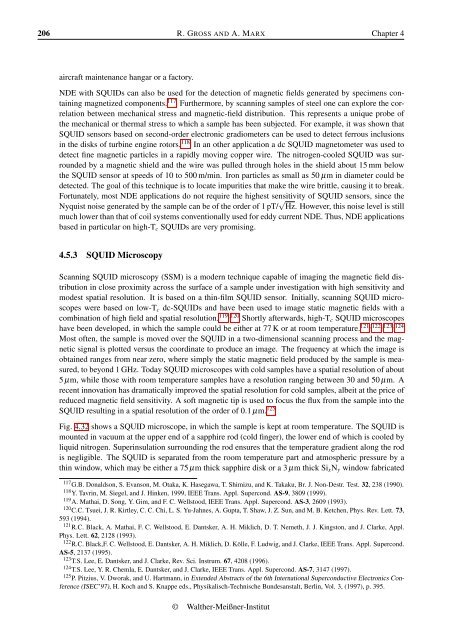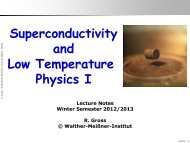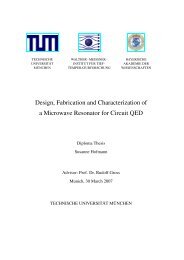Applied Superconductivity - Walther Meißner Institut - Bayerische ...
Applied Superconductivity - Walther Meißner Institut - Bayerische ...
Applied Superconductivity - Walther Meißner Institut - Bayerische ...
- No tags were found...
You also want an ePaper? Increase the reach of your titles
YUMPU automatically turns print PDFs into web optimized ePapers that Google loves.
206 R. GROSS AND A. MARX Chapter 4aircraft maintenance hangar or a factory.NDE with SQUIDs can also be used for the detection of magnetic fields generated by specimens containingmagnetized components. 117 Furthermore, by scanning samples of steel one can explore the correlationbetween mechanical stress and magnetic-field distribution. This represents a unique probe ofthe mechanical or thermal stress to which a sample has been subjected. For example, it was shown thatSQUID sensors based on second-order electronic gradiometers can be used to detect ferrous inclusionsin the disks of turbine engine rotors. 118 In an other application a dc SQUID magnetometer was used todetect fine magnetic particles in a rapidly moving copper wire. The nitrogen-cooled SQUID was surroundedby a magnetic shield and the wire was pulled through holes in the shield about 15 mm belowthe SQUID sensor at speeds of 10 to 500 m/min. Iron particles as small as 50 µm in diameter could bedetected. The goal of this technique is to locate impurities that make the wire brittle, causing it to break.Fortunately, most NDE applications do not require the highest sensitivity of SQUID sensors, since theNyquist noise generated by the sample can be of the order of 1 pT/ √ Hz. However, this noise level is stillmuch lower than that of coil systems conventionally used for eddy current NDE. Thus, NDE applicationsbased in particular on high-T c SQUIDs are very promising.4.5.3 SQUID MicroscopyScanning SQUID microscopy (SSM) is a modern technique capable of imaging the magnetic field distributionin close proximity across the surface of a sample under investigation with high sensitivity andmodest spatial resolution. It is based on a thin-film SQUID sensor. Initially, scanning SQUID microscopeswere based on low-T c dc-SQUIDs and have been used to image static magnetic fields with acombination of high field and spatial resolution. 119,120 Shortly afterwards, high-T c SQUID microscopeshave been developed, in which the sample could be either at 77 K or at room temperature. 121,122,123,124Most often, the sample is moved over the SQUID in a two-dimensional scanning process and the magneticsignal is plotted versus the coordinate to produce an image. The frequency at which the image isobtained ranges from near zero, where simply the static magnetic field produced by the sample is measured,to beyond 1 GHz. Today SQUID microscopes with cold samples have a spatial resolution of about5 µm, while those with room temperature samples have a resolution ranging between 30 and 50 µm. Arecent innovation has dramatically improved the spatial resolution for cold samples, albeit at the price ofreduced magnetic field sensitivity. A soft magnetic tip is used to focus the flux from the sample into theSQUID resulting in a spatial resolution of the order of 0.1 µm. 125Fig. 4.32 shows a SQUID microscope, in which the sample is kept at room temperature. The SQUID ismounted in vacuum at the upper end of a sapphire rod (cold finger), the lower end of which is cooled byliquid nitrogen. Superinsulation surrounding the rod ensures that the temperature gradient along the rodis negligible. The SQUID is separated from the room temperature part and atmospheric pressure by athin window, which may be either a 75 µm thick sapphire disk or a 3 µm thick Si x N y window fabricated117 G.B. Donaldson, S. Evanson, M. Otaka, K. Hasegawa, T. Shimizu, and K. Takaku, Br. J. Non-Destr. Test. 32, 238 (1990).118 Y. Tavrin, M. Siegel, and J. Hinken, 1999, IEEE Trans. Appl. Supercond. AS-9, 3809 (1999).119 A. Mathai, D. Song, Y. Gim, and F. C. Wellstood, IEEE Trans. Appl. Supercond. AS-3, 2609 (1993).120 C.C. Tsuei, J. R. Kirtley, C. C. Chi, L. S. Yu-Jahnes, A. Gupta, T. Shaw, J. Z. Sun, and M. B. Ketchen, Phys. Rev. Lett. 73,593 (1994).121 R.C. Black, A. Mathai, F. C. Wellstood, E. Dantsker, A. H. Miklich, D. T. Nemeth, J. J. Kingston, and J. Clarke, Appl.Phys. Lett. 62, 2128 (1993).122 R.C. Black,F. C. Wellstood, E. Dantsker, A. H. Miklich, D. Kölle, F. Ludwig, and J. Clarke, IEEE Trans. Appl. Supercond.AS-5, 2137 (1995).123 T.S. Lee, E. Dantsker, and J. Clarke, Rev. Sci. Instrum. 67, 4208 (1996).124 T.S. Lee, Y. R. Chemla, E. Dantsker, and J. Clarke, IEEE Trans. Appl. Supercond. AS-7, 3147 (1997).125 P. Pitzius, V. Dworak, and U. Hartmann, in Extended Abstracts of the 6th International Superconductive Electronics Conference(ISEC’97), H. Koch and S. Knappe eds., Physikalisch-Technische Bundesanstalt, Berlin, Vol. 3, (1997), p. 395.© <strong>Walther</strong>-Meißner-<strong>Institut</strong>
















